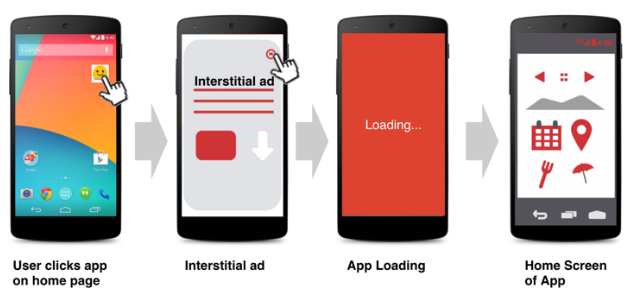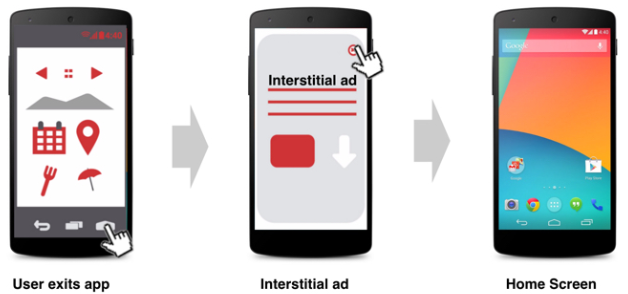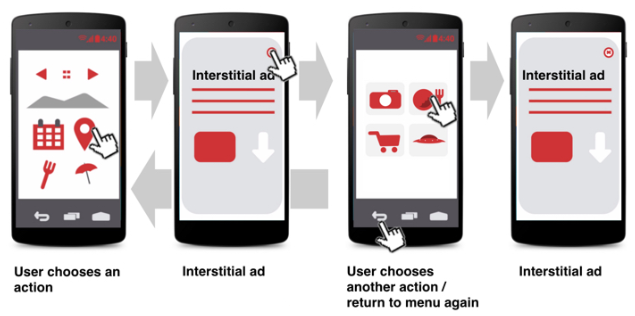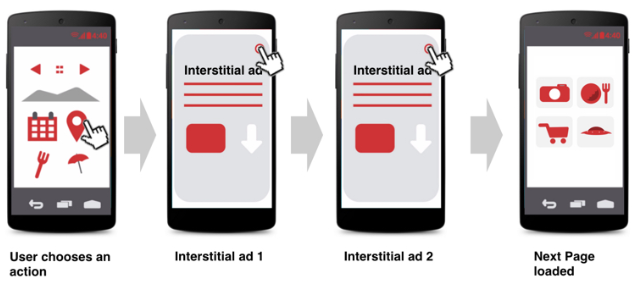One of the most primitive digital ad formats was the pop-up ad used in the early days of the Internet. Users would see large windows unexpectedly “popping up” in front of them, surely not to be missed. Eventually, pop-up blockers were created to provide a more positive user experience so that web browsing was not irritating.
Eventually, this ad type made its way back into the digital advertising world. Now commonly referred to as an interstitial ad.
What are interstitial ads?
Interstitial ads are interactive, full-screen ads that cover the interface of their host app or site. These ads appear between content, so they place at natural transition points or breaks, such as in between activities or game levels. Their full-coverage is what differentiates them from other ad types, like pop-up, native, and banner ads.
For reference, here’s an interstitial ads example (left), compared to a pop-up ad (middle) and banner ad (right):

Ad types include text, image, rich media, and video. Users can navigate past any of these by clicking or tapping on the ad to visit its destination or closing it to continue what they were doing previously.
The timing of the close option depends on ad type. Non-video ads will have an immediate close option:

Whereas interstitial video ads may have up to a 5-second delay before providing a close option:
 Interstitials can be found on desktop and mobile (as both iOS and Android full-screen ads). Considering the mobile-first world we live in, this article focuses on mobile interstitial ads.
Interstitials can be found on desktop and mobile (as both iOS and Android full-screen ads). Considering the mobile-first world we live in, this article focuses on mobile interstitial ads.
Penalties for mobile interstitial ads
Google now penalizes mobile pages containing interstitials, simply because obstructing content on mobile with ads is against their guidelines.
On mobile devices (smaller screen), it’s not always easy to find the ‘X,’ ‘Close,’ or ‘Continue to site’ link. Even when you see it, tapping it is difficult due to its size and placement. So while the desktop version is annoying, mobile interstitials can ruin the entire user experience.
As of November 1, 2015, Google’s mobile-friendly test began excluding any mobile web page from the “mobile-friendly” category that showed an app install interstitial after clicking from the search result page. Then starting January 10, 2017, mobile pages where content is not easily user-accessible from the mobile search results may not rank as high.
More disallowed interstitial implementations include:
Immediately upon app load or exit
Interstitials ads should not appear immediately after a user clicks on an app:

Or when they try to exit the app:

Repeating or recurring
Google does not allow to place an interstitial ad after every user action (clicks, swipes, etc.).

As is displaying back-to-back ads after the user closes one:

As a rule of thumb, don't include more than one ad between every two user actions within your app.
Unexpectedly launched
Interstitials suddenly appear when a user is focusing on a task at hand (e.g. playing a game, filling out a form, reading content) may lead to accidental clicks:

Penalty exceptions
Not all interstitials are targeted for penalty, meaning they don’t require a change of ad size, design, or position. Exceptions include:
Cookie usage interstitials
Interstitial ads used for cookie consent notifications as required by the EU are permitted:

Age verification interstitials
Google allows age verification interstitials that act as a shield for certain content, such as alcohol-related or adult-related content:

Page-to-page interstitials
Displaying an interstitial ad when a user navigates from one of your pages to another page is acceptable. However, if a user can find that page with a Google search, it can’t include any interstitials.
Why use interstitials?
Interstitial ads are one of the most popular mobile ad formats used by developers and marketers because of their high impression rate to increase downloads and revenue. Well-known companies have seen significant increases in app installs by optimizing interstitials, including Pinterest and Airbnb with an increase of 100% and 300%, respectively.
Why prefer Interstitial ads:
- Larger sizes leave larger impressions on users
- Higher impression rates mean higher click-through rates
- Increased click-through rates lead to increased conversion rates
Interstitials can have downfalls too if not used in accordance with some best practices. Without following the rules and recommendations below, your ads may generate less traffic and conversions, and apps may see lower user retention.
3 interstitial ads best practices
1. Create a seamless flow
When it comes to positioning, it’s not only important to remember the penalties for certain positions; you must keep in mind that interstitials work for linear user experiences. This means there should be a very clear start and stop points within the app, and the ads should complement the natural flow of user engagement. By presenting an interstitial at an expected break, distinct stopping point, or user-based pause, you’re much less likely to disrupt the user experience.
It’s recommended they appear before the break page (a page that typically requires a user to tap a next (or continue, etc.) button to proceed. Ads that appear immediately after clicking a button can be surprising, leading to accidental ad clicks, and easily hurt your conversion rate.
Also, pause any app actions while the ad is showing. For example, pause any audio output from your main app and temporarily halt any intense tasks. This will help ensure the user doesn't experience slow or unresponsive graphics or video.
2. Consider frequency and timing
One of the main reasons people uninstall apps is intrusive advertising, so be sure not to flood the user with interstitials. It may be tempting to increase the frequency, but it can affect the user experience if the ads interrupt the user where they can’t enjoy the app.
If an app requires frequent tapping by users, consider inserting a delay (a “loading” or “please wait” screen, or a progress bar or wheel) after the end of a level before your interstitial ad shows. This gives users a chance to stop tapping the screen and carefully consider what appears next -- again, helping to reduce accidental clicks.
3. Direct targeted traffic to dedicated post-click landing pages
Make sure your ad offer can be easily accessed by sending prospects directly to a dedicated post-click landing page instead of your website. post-click landing pages help convert prospects into leads since they rely on persuasive elements (compelling copy, convincing testimonials, trust badges, etc.) and free of distractions (header/footer navigations, social media links, etc.)
Consider adding interstitial ads to your campaigns
Interstitial ads have the potential to deliver high impression rates, click-through rates, conversion rates, and revenue. Follow the tips and best practices above to ensure you’re getting the most out of your interstitial campaigns.
For the most up-to-date ad specs and targeting options, refer to the Instapage digital advertising specs guide. It contains everything you should know about advertising on every major advertising -- dimensions, file formats, examples, and more -- all in one place. Then be sure to complete your ad campaign with an optimal post-click landing page from ad to post-click landing page with Instapage — the most robust post-click optimization platform.

